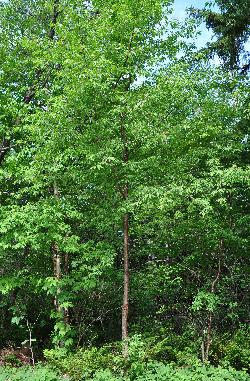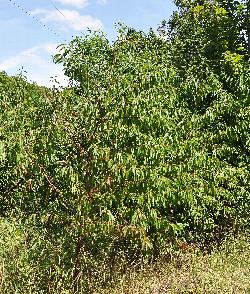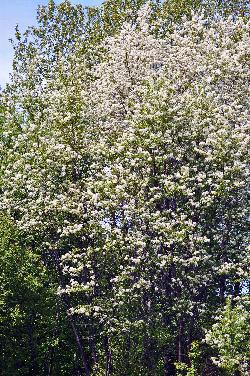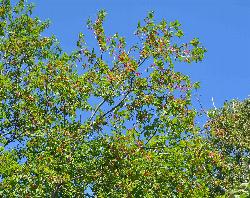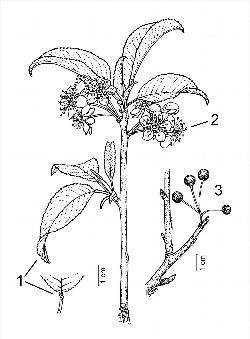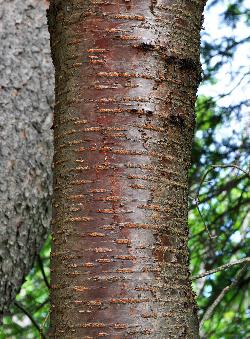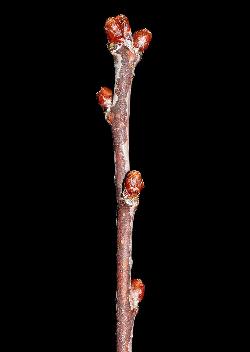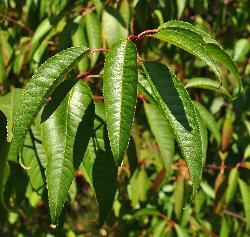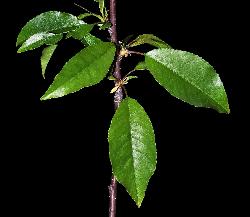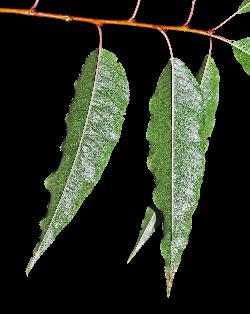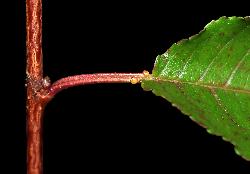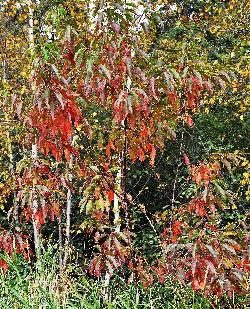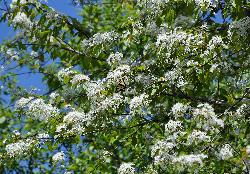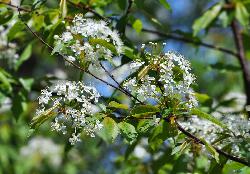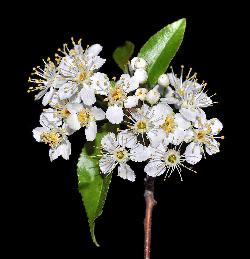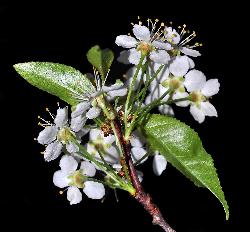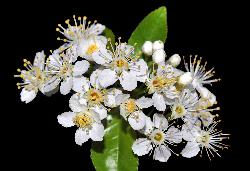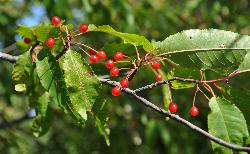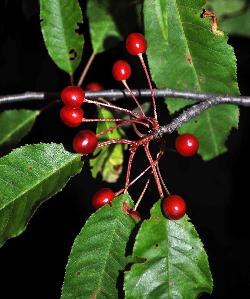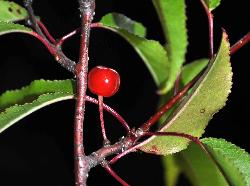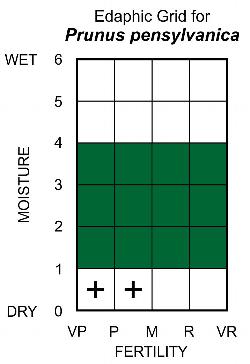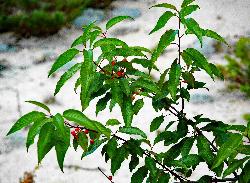Fr: cerisier de Pennsylvanie, arbre à petit merisier, cerisier d'été
IA: upueiminanakashi, upueiminan
Rosaceae - Rose Family
Note: Numbers provided in square brackets in the text refer to the image presented above; image numbers are displayed to the lower left of each image.
General: A tall deciduous shrub or tree, to 12 m tall, with umbellate clusters of white flowers followed by small bright red cherries 1–4. Mature trees may grow to a d.b.h. of 10–51 cm, but pin cherry is generally a short-lived shrub to small tree, persisting for 20–40 years (Anderson 2004). Pin cherry is a shade-intolerant, shallow-rooted, pioneer species of dry well-drained sites, typically found in early to mid successional stages of forests following disturbance (Anderson 2004, Wendell 1990), and often reproducing vegetatively by root sprouts to forms thickets. Pin cherry fruits are eaten by a variety of birds, including grouse and ptarmigan, and are also consumed by chipmunks, and beavers, but are poisonous to livestock (VanDersal 1938). Moose in Newfoundland reportedly have an aversion to pin cherry and will regurgitate the leaves (Munro 2013). Warning: Pin cherry leaves and seeds contain cyanogenic glucoside compounds, specifically amygdalin and prunasin, which release toxic hydrogen cyanide (HCN) when the leaves or seeds are chewed or crushed. However, the flesh of pin cherry fruits is edible and can be used to make jams or jellies, but the pits should be removed prior to cooking.
Black knot is an ascomycete fungal disease (Apiosporina morbosa (Schw. ex Fr.) Arx) that produces unsightly irregularly-shaped black swellings (stromata) on the shoots of many Prunus species, especially pin cherry [5], which result in decreased fruit set and premature death of shoots and trees (Wall 1986). Ascospores, produced within the ‘knots’ or stromata in the spring, usually infect developing shoots shortly after trees start to leaf out. Infection occurs more quickly in pin cherry stands established after logging rather than in stands established after fire (Wall 1986). In urban areas, the spread of black knot to adjacent pin cherry stands can be limited or controlled by pruning branches with developing stromata about 20 cm below each knot, followed by immediate burning of the branches (Spencer 2003). The best time to remove infected branches is in late fall or winter, before new ascospores are released in the spring. Diseased branches should be burned immediately after removal, since spores can continue to be produced within the stromata for up to 4 months after pruning (Spencer 2003).
Key Features: (numbers 1–3 refer to the illustration [6])
1. Leaves alternate and simple, with lanceolate to ovate blades that tapers gradually to an acute or acuminate apex, bases are tapering to rounded, and leaf margins are
crenate-serrate with rounded teeth; 1–3 disk-shaped glands are borne at the top of the petiole.
2. Several clusters of 2–7 flowers are arranged in domed umbellate-clusters at the end of 1-year-old branches. Individual flowers are 5–7.5 mm across and have a
hypanthium with 5 reflexed calyx lobes, 5 white petals, 25–30 stamens, and a single superior ovary.
3. Small clusters of globose bright red drupes, 4-7 mm in diameter, are borne on long pedicels 1–3 cm long; the single seed is enclosed within a stony pit.
Stems/twigs: The shiny, dark reddish-brown bark is marked by numerous prominent horizontal rust-coloured lenticels [7]. Twigs are reddish-brown or purplish-brown, glabrous, and have a disagreeable bitter almond taste and smell when crushed. Buds are small, ovoid, and blunt, with several overlapping reddish-brown bud scales [8]. Buds are alternately-arranged along the twig, with several blunt buds clustered at the tip. Leaf scars are small and semicircular with 3 bundle trace scars.
Leaves: Alternate, simple, pinnately-veined, and petiolate. Leaf blades are usually lanceolate, but may be elliptic, oblong-lanceolate, to ovate and 4–11 cm long by 1.5–5 cm wide; the upper surface is yellow-green to dark green, glabrous, and somewhat shiny to lustrous [9–10]; the lower surface is paler and glabrous [11]. Leaf bases are cuneate to rounded, the blade narrows gradually to an acute or acuminate apex that often curves downward, margins are flat to somewhat undulate and finely crenate-serrate [12], with blunt to rounded teeth that are gland-tipped when young. The petiole is green to reddish, about 1–2 cm long, and bears 1–3 flat disk-like glands just below the junction of the petiole and blade [13]. Emerging leaves are often bronze-tinged; in autumn, leaves turn yellow, orange, or red [14].
Flowers: Bisexual, arranged in umbel-like clusters (corymbs) of 2–7 flowers, each 1.2–1.6 cm across, borne on short shoots near the end of 1-year-old branches [15–17]; the pedicels are 1–2 cm long. The calyx forms a cup-shape hypanthium that surrounds the single, superior ovary; the inner surface of the hypanthium is often orange in colour and secretes nectar [18]. Attached to the rim of the hypanthium are 5 reflexed blunt-triangular calyx lobes, 5 white short-clawed obovate to orbicular petals, 4–7 mm long, and 25–30 stamens [19–21]. Flowers bloom as the leaves emerge in late May to early June. Pollination is by a variety of insects (entomophily).
Fruit: A small bright red globose drupe, 4–8 mm in diameter, turning from opaque to translucent red at maturity [22–24]; fruit are borne on slender pedicels, 1–3 cm long. The fruit has edible, but tart, juicy flesh and an ovoid stony pit (the endocarp), 4–5 mm in diameter, which contains a single seed. Fruits mature in late summer. Pin cherry fruits are dispersed by frugivorous birds, small mammals (endozoochory), and by gravity (barochory) (Wendel 1990).
Ecology and Habitat: Pin cherry occurs with low abundance and frequency in mature forests over a wide range of soil moisture and nutrient regimes. It is more commonly encountered on cutovers, burns, windthrows and insect-killed stands, where it colonizes from dormant seeds buried in the forest floor. Seedlings can quickly increase cover through root sprouting and form a significant component of hardwood thickets, in association with birch and aspen, during the 6–10-year seral stage following forest canopy removal. Although it is most commonly encountered as a tall shrub in Newfoundland and Labrador, tree-sized pin cherry may be encountered in old forest openings and clearings. Pin cherry also occurs in disturbed areas, rocky slopes, sandy soils, rights-of-way, and roadsides.
Edaphic Grid: See image [25]: the Edaphic Grid for Prunus pensylvanica.
Forest Types: Pin cherry is known to occur in the following forest types:
Abietum dryopteretosum (Dryopteris-Balsam Fir Forest Subassociation)
Abietum hylocomietosum (Hylocomium-Balsam Fir Forest Subassociation)
Abietum typicum (Pleurozium-Balsam Fir Forest Subassociation)
Betuletum dryopteretosum (Dryopteris-Birch Forest Subassociation)
Betuletum kalmietosum (Kalmia-Birch Forest Subassociation)
Betuletum rubetosum (Rubus-Birch Forest Subassociation)
Betuletum typicum (White Birch-Mountain Alder Forest Subassociation)
Piceetum marianae (Black Spruce Forest Association)
Prunetum caricetosum (Sedge-Pin Cherry Thicket Subassociation)
Prunetum deschampsietosum (Heath Grass-Pin Cherry Thicket Subassociation)
Prunetum typicum (Pin Cherry-Birch Thicket Subassociation)
In southeastern Labrador, Foster (1984) recorded pin cherry with 46% frequency and 3–10% cover in his Birch Forest community, 10% frequency and less than 3% cover in his Fir-Spruce Feathermoss Forest community and 8% frequency with less than 3% cover in his Spruce-Pleurozium Forest community. In central Labrador, pin cherry was occasionally encountered in blow-outs on sand terraces bordering the Lower Churchill River [26].
Succession: Even though the occurrence of pin cherry is sporadic in mature coniferous forests, it maintains its prominence as an early successional species through a combination of buried seed strategy and avian seed dispersal, which ensures reasonably large populations of buried viable seeds in the soils of forests, well after the disappearance of pin cherry from a particular site (Marks 1974). Seeds can remain viable for 50–100 years (Anderson 2004). The exact mechanism that triggers seed germination is not fully understood, but is thought to be a combination of aging of the endocarp and response to increase temperature and light associated with removal of the mature forest canopy by disturbance events (Anderson 2004). Osawa (1994) found that pin cherry seedlings were more abundant under 100% defoliated spruce-fir forests in Maine than under partial defoliation.
Pin cherry and other shrubs play an important function in early stages of forest succession after disturbance by reducing runoff through evapotranspiration and retaining nutrients that might otherwise be lost to the ecosystem (Marks and Bormann 1972).
In surveys of cutovers in central Newfoundland, pin cherry was only found in low abundance in the 6–20 year seral stage of Hylocomium-Balsam Fir Forest and Pleurozium-Balsam Fir Forest types (Northland Associates 1990). In eastern Newfoundland, W.J. Meades (1986) defined three types of Pin Cherry-Birch Thickets, where pin cherry ranged from 10–25 % cover.
Distribution: Pin cherry is native to north-temperate and boreal North America; its range extends across Canada, from Newfoundland and Labrador west to central British Columbia, extending north into the Northwest Territories (Scoggan 1978). Pin cherry is found across insular Newfoundland, but is absent from the Great Northern Peninsula; in Labrador, it occurs as far north as the Churchill River Valley, central Labrador (Scoggan 1978, Minaskuat Ltd. 2007) and western Labrador, near the Esker area (Day 1999). In the United States, pin cherry occurs from New England south along the Appalachian Mountains to northeastern Georgia and west along the States that border the Great Lakes, from New York to Minnesota. It is found less commonly in Iowa, North Dakota, South Dakota, Montana, Wyoming, and Colorado (USDA, NRCS 2016 ).
Similar Species: In wet habitats, leaves of the shining willow (Salix lucida Muhl.), may be mistaken for pin cherry, but shining willow leaves have a longer, narrower, attenuate to caudate apex, shorter petioles, 0.5–1.5 cm long, and prominent stipules; pin cherries lack stipules and have 1–2 disk-shaped glands at the top of the petiole.
Vigorous root shoots of pin cherry may have very large robust leaves that resemble those of chokecherry (Prunus virginiana L.), but chokecherry leaves are usually obovate, widest above the middle, and have flowers and fruit arranged in long racemes; chokecherry fruits are ovoid and turn from green to red, but are dark purplish-black at maturity.


